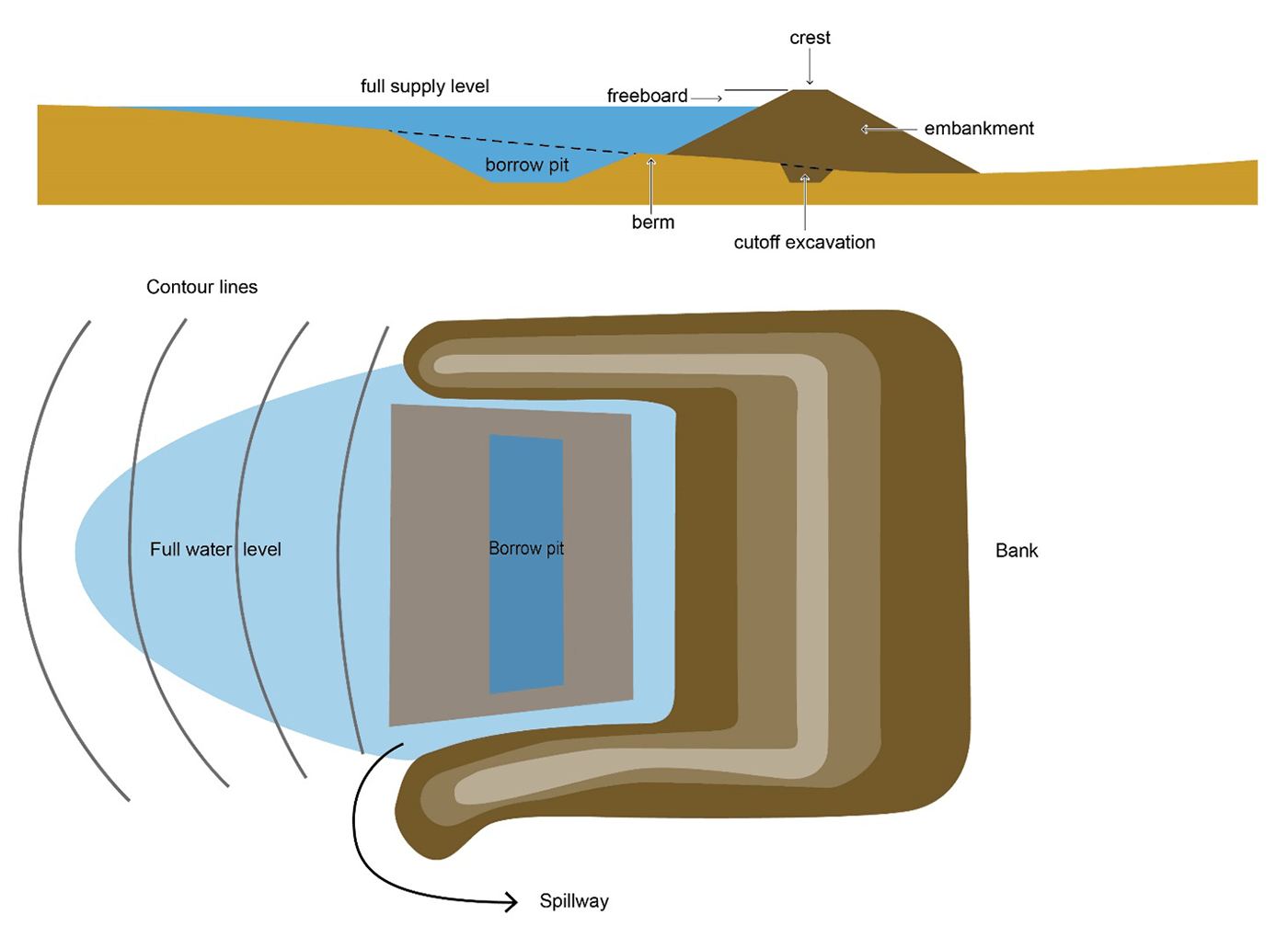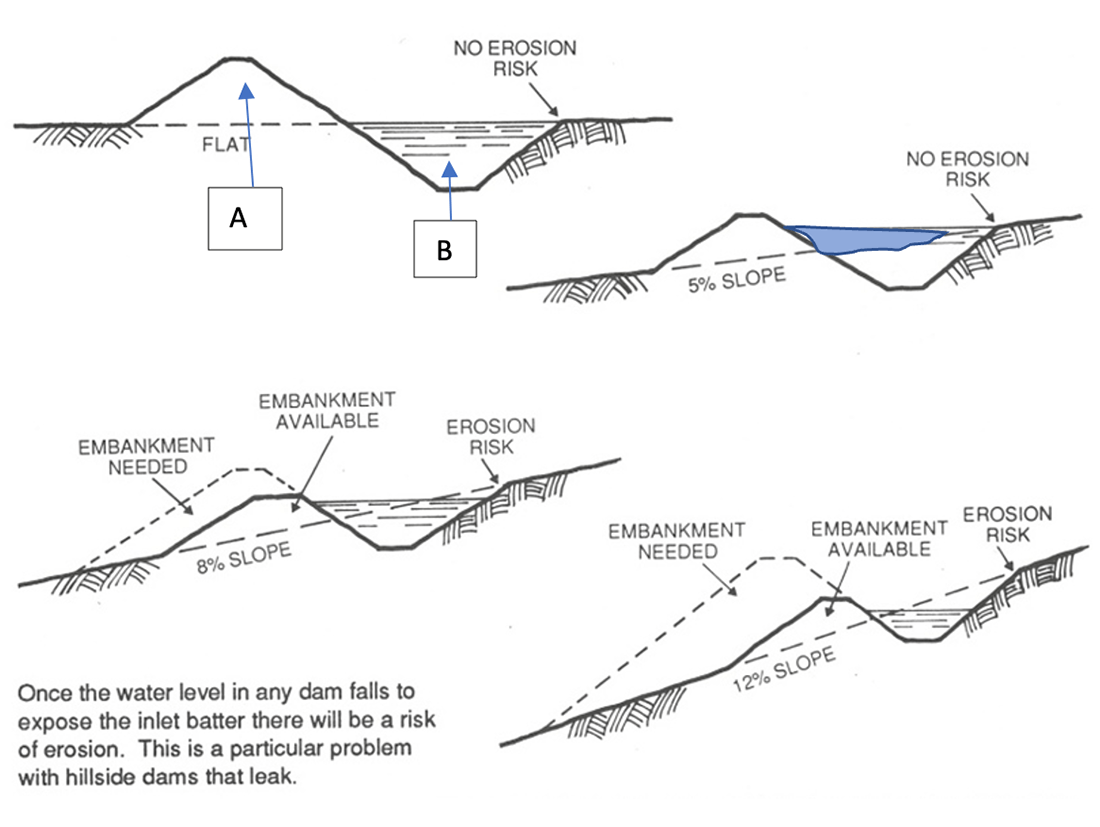Planning a new farm dam
This section will outline:
- Water storage requirements
- Required catchment area
- Regulations on farm dam construction
- Suitable sites for constructing a stable dam with optimum storage to excavation ratio
See Appendix 1 for a worked example of applying these principles to a farm in Illabo, NSW.
Water storage requirements
Undertaking farm water planning as outlined in Section 1 provides a picture of the water storage needs of a farm. When planning a specific dam, undertake the following steps:
- Calculate water consumption according to use (e.g. stock, irrigation, house and garden) over a year. Sample tables for NSW are included in Appendix 1. Calculate the total amount of water expected to be required in a single year.
- Work out the Critical Storage Period – how long the water needs to last for (consider dry times such as drought). The Critical Storage Period effectively provides a multiplication factor – if the period is two years, then the figure obtained in step 1 should be doubled.
- Evaporation rates can vary significantly – seek local advice on expected evaporation rates. A good rule of thumb is that most dams will lose one metre per year (from the total dam surface area). This means that for 4ML of water, a 6ML dam is likely required.
Dam size required = annual water consumption x Critical Storage Period x Evaporation allowance
Required catchment area and peak discharge
Catchment yield
There is no point building a large dam, only to find that the catchment will not yield enough water to fill it. The Catchment yield equation can be used to determine the amount of runoff that can be collected from a catchment of a particular size.
Catchment yield (kilolitres) = Area (ha) x Rainfall (mm) x Percentage runoff (%)
To work out the area required to deliver a particular volume of water, the equation can be rearranged as follows:
Area (ha) = Catchment yield (kl) / ( Rainfall (mm) x Percentage runoff (%) )
Percentage runoff is the percentage of rainfall that runs off the ground, which is based on the soakage ability of the soil. See Appendix 1, Table 4, for percentage runoff figures for different soil types.
Peak discharge and spillway width
It is also vital to understand the flood flows that a catchment can produce, as this will assist in forecasting how soon the dam is likely to fill as well as the spillway width required. Note that it is much better to have a spillway that is too wide than too narrow. Longer, wider spillways provide good opportunities for biodiversity improvements.
Dam construction regulations
Landholders have a right to access a share of water, but these rights are regulated. This means that in some cases dams can be constructed without a license, while in others a license is required.
It is also advisable to contact the NSW Department of Primary Industries or relevant authority in your region for advice on maintaining fish passage through dam structures.
NSW
In Central and Eastern NSW, the NSW Farm Dams Policy allows for landholders to capture and store the first 10% of runoff (the “harvestable right”) that occurs on first and second order streams on a property, without a license.
The Maximum Harvestable Right Dam Capacity (MHRDC) is the total dam capacity allowed under the harvestable right for a specific property, and takes into account rainfall, variations in rainfall pattern and evaporation rates. To calculate the MHRDC for your property visit www.waternsw.com.au and search for “harvestable right”. (Ensure you know the capacity of existing dams on the property, as these will contribute towards your MHRDC and must be taken into account when working out the maximum size of any new dams.) Appendix 1 provides an example calculation of MHRDC in NSW.
To determine whether your proposed dam is located on a first or second order stream visit bit.ly/nswhydrodata (also see Appendix 1, Figure 9).
In NSW, dams cannot be constructed on or within 3 km of a RAMSAR wetland site. There are 12 RAMSAR wetland sites in NSW (check the NSW Department of Planning, Industry and Environment website).
Victoria
In Victoria, dams constructed on a waterway require a license, while dams that are not constructed on a waterway may require a license depending on size and wall height.
For details visit www.water.vic.gov.au/water-for-agriculture/taking-and-using-water/private-dam-licensing .
Site selection
The next step is to find a suitable dam site that meets regulatory requirements and also:
- Utilises suitable water holding soils
- Has a cost-efficient storage to excavation ratio
- Takes into account environmental factors such as erosion, supporting biodiversity and managing stock access.
It is easier to build large dams in flatter country, while steep country can mean opportunities to build dams are limited.
Soil composition and compaction
The ideal soil for dam construction has the following composition:
| Sand | 40-60% |
| Silt | 10-20% |
| Clay | 20-40% |
It is ideal to have some minor dispersible clay present so that the clay will move between the sand and silt particles to help form a water tight seal. Ideally the clay should not be prone to excessive shrinking or swelling, to minimise the development of cracks in the wall.
A suite of basic soil tests should be undertaken to determine if the soil will hold water, or if additional measures are required.If dam must be built out of material that is outside the ideal range it is recommended that a plastic liner be placed in the wall of the dam, or the incorporation of gypsum at rate of 1t/750m 3 of earth moved. See Appendix 1 for additional information on soil testing.
The soil needs to be compacted (this is usually done with a roller and a water cart on site) to keep the dam wall material close to optimal moisture content. Compaction is critical to expel air from soil pore spaces, with the remaining water helping fine particles to stick to the larger silt and sand particles. The compaction should ideally occur in layers 150-200mm thick that are compacted at optimum moisture content by a roller to ensure that compaction effort is spread evenly through each layer. The moisture and compaction effort also helps the dispersed clays to move into the old air pore spaces.
Storage to excavation ratio
To minimise costs when building a dam, choose a site that will enable high water storage for minimal earth moving costs. The excavation of the dam storage should provide enough earth to build the dam wall. This relationship is the storage to excavation ratio.
These considerations necessitate careful site selection to ensure that sufficient storage can be created without the need for an enormous, expensive dam wall.
Most agricultural dams are created by the building of an embankment using material excavated to create the dam pit. The best storage to excavation ratio is found by damming a narrow gully that widens upstream of the dam, and where the slope of the gully floor is less than 2% (Figure 7).
Alternatively, a hillside dam where the hill slope is less than 5% works well (Figure 8). At this slope the extra free water reaches its maximum (the area highlighted in blue in Figure 6). As slope increases beyond 5% the amount of extra free water decreases and extra earth is required to build the wall – storage to excavation ratio thus falls and costs become inefficient (Figure 9).
For both gully dams and hillside dams, the shallow area at the back of the dam can be used for planting sedges, reeds and grasses.
Figure 7: Typical configuration of a gully dam designed for multiple benefits. Note the cutoff trench underneath the dam wall.1

Figure 8: Typical configuration of a hillside dam.2

Figure 9: The storage to excavation ratio becomes increasingly inefficient for hillside dams built on slopes greater than 5%. Greater slopes also mean a greater risk of erosion on the upstream side of the dam.3

Other site selection considerations
There are a number of other factors in dam site selection that will help minimize environmental impacts caused by a dam and enable the dam to contribute positively to biodiversity.
Factors to consider include:
- Is the area below the dam site suitable and stable enough to return excess flows back to the flowline without erosion?
- Does the chosen site provide the opportunity for shallow areas in the dam? Shallow areas are particularly important for supporting wildlife and enabling the growth of fringing vegetation that will help filter inflows, keep the water cleaner and support biodiversity.
- Can the dam be easily fenced to exclude stock? For example, is it close to an existing fence line that can be extended? Excluding stock from a dam enables the growth of fringing vegetation that will shelter and filter the water, and prevents stock from pugging the dam edge and fouling the water.
- Is the site suitable for enabling alternative access to water for stock – either by building a hardened access point for stock, or by piping water to a trough or troughs?
- What impact will the dam have on downstream water catchments? Following the dam building regulations in your region will mitigate these impacts, but bear in mind the potential impact on riparian areas or other dams downstream on your property.
Further resources for farm dam design and construction
Harris, G (1989) Water Supply and Farm Dam Construction, Soil Conservation Service.
Nelson, KD (1985) Design and Construction of Small Earth Dams, Inkata Press.
O’Connor, J & Yiasoumi, B (2009) Primefact 781.Building a farm dam. NSW Department of Industry and Investment.
1Rural Earthmoving in the Sydney Drinking Water Catchment (2014, Sydney Catchment Authority).
2Rural Earthmoving in the Sydney Drinking Water Catchment (2014, Sydney Catchment Authority).
3 Greentree, D & Jackson, L (1991) Earth Movers Training Course - Unit 9 Farm Dams . Soil Conservation Service of NSW.

